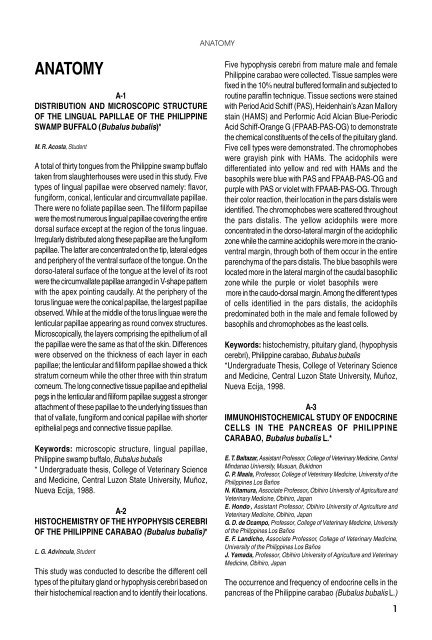THE PHILIPPINE WATER BUFFALO
THE PHILIPPINE WATER BUFFALO
THE PHILIPPINE WATER BUFFALO
You also want an ePaper? Increase the reach of your titles
YUMPU automatically turns print PDFs into web optimized ePapers that Google loves.
ANATOMY<br />
A-1<br />
DISTRIBUTION AND MICROSCOPIC STRUCTURE<br />
OF <strong>THE</strong> LINGUAL PAPILLAE OF <strong>THE</strong> <strong>PHILIPPINE</strong><br />
SWAMP <strong>BUFFALO</strong> (Bubalus bubalis)*<br />
M. R. Acosta, Student<br />
A total of thirty tongues from the Philippine swamp buffalo<br />
taken from slaughterhouses were used in this study. Five<br />
types of lingual papillae were observed namely: flavor,<br />
fungiform, conical, lenticular and circumvallate papillae.<br />
There were no foliate papillae seen. The filiform papillae<br />
were the most numerous lingual papillae covering the entire<br />
dorsal surface except at the region of the torus linguae.<br />
Irregularly distributed along these papillae are the fungiform<br />
papillae. The latter are concentrated on the tip, lateral edges<br />
and periphery of the ventral surface of the tongue. On the<br />
dorso-lateral surface of the tongue at the level of its root<br />
were the circumvallate papillae arranged in V-shape pattern<br />
with the apex pointing caudally. At the periphery of the<br />
torus linguae were the conical papillae, the largest papillae<br />
observed. While at the middle of the torus linguae were the<br />
lenticular papillae appearing as round convex structures.<br />
Microscopically, the layers comprising the epithelium of all<br />
the papillae were the same as that of the skin. Differences<br />
were observed on the thickness of each layer in each<br />
papillae; the lenticular and filiform papillae showed a thick<br />
stratum corneum while the other three with thin stratum<br />
corneum. The long connective tissue papillae and epithelial<br />
pegs in the lenticular and filiform papillae suggest a stronger<br />
attachment of these papillae to the underlying tissues than<br />
that of vallate, fungiform and conical papillae with shorter<br />
epithelial pegs and connective tissue papillae.<br />
Keywords: microscopic structure, lingual papillae,<br />
Philippine swamp buffalo, Bubalus bubalis<br />
* Undergraduate thesis, College of Veterinary Science<br />
and Medicine, Central Luzon State University, Muñoz,<br />
Nueva Ecija, 1988.<br />
A-2<br />
HISTOCHEMISTRY OF <strong>THE</strong> HYPOPHYSIS CEREBRI<br />
OF <strong>THE</strong> <strong>PHILIPPINE</strong> CARABAO (Bubalus bubalis)*<br />
L. G. Advincula, Student<br />
This study was conducted to describe the different cell<br />
types of the pituitary gland or hypophysis cerebri based on<br />
their histochemical reaction and to identify their locations.<br />
ANATOMY<br />
Five hypophysis cerebri from mature male and female<br />
Philippine carabao were collected. Tissue samples were<br />
fixed in the 10% neutral buffered formalin and subjected to<br />
routine paraffin technique. Tissue sections were stained<br />
with Period Acid Schiff (PAS), Heidenhain’s Azan Mallory<br />
stain (HAMS) and Performic Acid Alcian Blue-Periodic<br />
Acid Schiff-Orange G (FPAAB-PAS-OG) to demonstrate<br />
the chemical constituents of the cells of the pituitary gland.<br />
Five cell types were demonstrated. The chromophobes<br />
were grayish pink with HAMs. The acidophils were<br />
differentiated into yellow and red with HAMs and the<br />
basophils were blue with PAS and FPAAB-PAS-OG and<br />
purple with PAS or violet with FPAAB-PAS-OG. Through<br />
their color reaction, their location in the pars distalis were<br />
identified. The chromophobes were scattered throughout<br />
the pars distalis. The yellow acidophils were more<br />
concentrated in the dorso-lateral margin of the acidophilic<br />
zone while the carmine acidophils were more in the cranioventral<br />
margin, through both of them occur in the entire<br />
parenchyma of the pars distalis. The blue basophils were<br />
located more in the lateral margin of the caudal basophilic<br />
zone while the purple or violet basophils were<br />
more in the caudo-dorsal margin. Among the different types<br />
of cells identified in the pars distalis, the acidophils<br />
predominated both in the male and female followed by<br />
basophils and chromophobes as the least cells.<br />
Keywords: histochemistry, pituitary gland, (hypophysis<br />
cerebri), Philippine carabao, Bubalus bubalis<br />
*Undergraduate Thesis, College of Veterinary Science<br />
and Medicine, Central Luzon State University, Muñoz,<br />
Nueva Ecija, 1998.<br />
A-3<br />
IMMUNOHISTOCHEMICAL STUDY OF ENDOCRINE<br />
CELLS IN <strong>THE</strong> PANCREAS OF <strong>PHILIPPINE</strong><br />
CARABAO, Bubalus bubalis L.*<br />
E. T. Baltazar, Assistant Professor, College of Veterinary Medicine, Central<br />
Mindanao University, Musuan, Bukidnon<br />
C. P. Maala, Professor, College of Veterinary Medicine, University of the<br />
Philippines Los Baños<br />
N. Kitamura, Associate Professor, Obihiro University of Agriculture and<br />
Veterinary Medicine, Obihiro, Japan<br />
E. Hondo , , Assistant Professor, Obihiro University of Agriculture and<br />
Veterinary Medicine, Obihiro, Japan<br />
G. D. de Ocampo, Professor, College of Veterinary Medicine, University<br />
of the Philippines Los Baños<br />
E. F. Landicho, Associate Professor, College of Veterinary Medicine,<br />
University of the Philippines Los Baños<br />
J. Yamada, Professor, Obihiro University of Agriculture and Veterinary<br />
Medicine, Obihiro, Japan<br />
The occurrence and frequency of endocrine cells in the<br />
pancreas of the Philippine carabao (Bubalus bubalis L.)<br />
1


